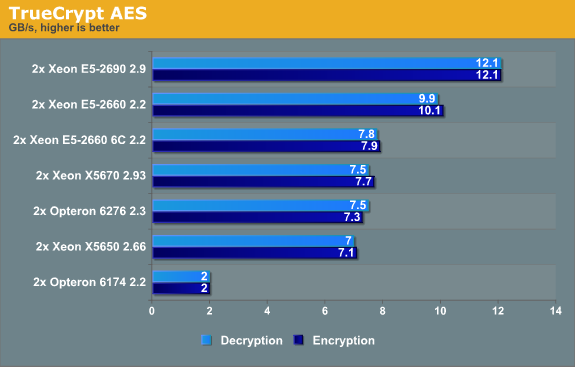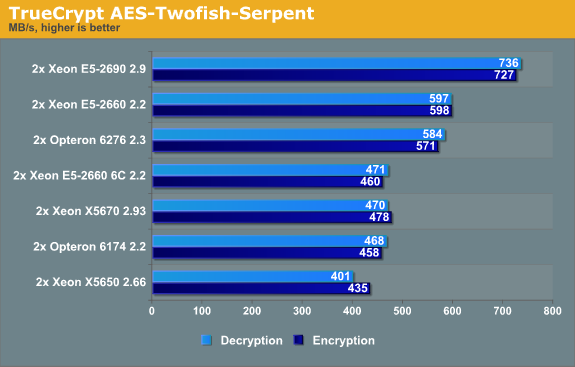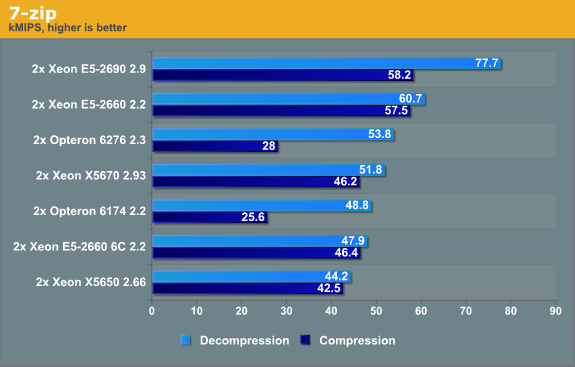The Xeon E5-2600: Dual Sandy Bridge for Servers
by Johan De Gelas on March 6, 2012 9:27 AM EST- Posted in
- IT Computing
- Virtualization
- Xeon
- Opteron
- Cloud Computing
TrueCrypt 7.1 Benchmark
TrueCrypt is a software application used for on-the-fly encryption (OTFE). It is free, open source and offers full AES-NI support. The application also features a built-in encryption benchmark that we can use to measure CPU performance. First we test with the AES algorithm (256-bit key, symmetric).

Core for Core, clock for clock, the Xeon E5 - which also supports AES-NI - is about 30% faster than the best Opteron (Xeon E5-2660 vs Opteron 6276). At a similar pricepoint (Opteron 6276 vs Xeon E5-2660 6C) however, the Opteron and Xeon E5 perform more or less the same, with a small advantage for the latter.
We also test with the heaviest combination of the cascaded algorithms available: Serpent-Twofish-AES.

The combination benchmark is limited by the slowest algorithms: Twofish and Serpent. This one of the few benchmarks where the Opteron 6276 is able to keep up with the Xeon E5.
It is important to realize that these benchmarks are not real-world but rather are synthetic. It would be better to test a website that does some encrypting in the background or a fileserver with encrypted partitions. In that case the encryption software is only a small part of the total code being run. A large performance (dis)advantage might translate into a much smaller performance (dis)advantage in that real-world situation. For example, eight times faster encryption resulted in a website with 23% higher throughput and a 40% faster file encryption (see here).
7-Zip 9.2
7-zip is a file archiver with a high compression ratio. 7-Zip is open source software, with most of the source code available under the GNU LGPL license

Compression is more CPU intensive than decompression, meanwhile the latter depends a little more on memory bandwidth. When it comes to load/stores and memory bandwidth, the Xeon E5-2660 is about 13% faster than AMD's flagship. Compression is for a part determined by the quality of the branch predictor. The new and improved Sandy Bridge branch predictor is one of the reasons why a 2.2 GHz 6-core 2660 is able to keep up with a 2.93 GHz (!) Xeon 5670, which is also a six-core processor. The Opterons get blown away in the compression benchmark: each core of Xeon E5 is about twice as efficient in this task. The overall winner is thus once again the Xeon E5.










81 Comments
View All Comments
alpha754293 - Tuesday, March 6, 2012 - link
Thanks for running those.Are those results with HTT or without?
If you can write a little more about the run settings that you used (with/without HTT, number of processes), that would be great.
Very interesting results thought.
It would have been interesting to see what the power consumption and total energy consumption numbers would be for these runs (to see if having the faster processor would really be that beneficial).
Thanks!
alpha754293 - Tuesday, March 6, 2012 - link
I should work with you more to get you running some Fluent benchmarks as well.But, yes, HPC simulations DO take a VERY long time. And we beat the crap out of our systems on a regular basis.
jhh - Tuesday, March 6, 2012 - link
This is the most interesting part to me, as someone interested in high network I/O. With the packets going directly into cache, as long as they get processed before they get pushed out by subsequent packets, the packet processing code doesn't have to stall waiting for the packet to be pulled from RAM into cache. Potentially, the packet never needs to be written to RAM at all, avoiding using that memory capacity. In the other direction, web servers and the like can produce their output without ever putting the results into RAM.meloz - Tuesday, March 6, 2012 - link
I wonder if this Data Direct I/O Technology has any relevance to audio engineering? I know that latency is a big deal for those guys. In past I have read some discussion on latency at gearslutz, but the exact science is beyond me.Perhaps future versions of protools and other professional DAWs will make use of Data Direct I/O Technology.
Samus - Tuesday, March 6, 2012 - link
wow. 20MB of on-die cache. thats ridiculous.PwnBroker2 - Tuesday, March 6, 2012 - link
dont know about the others but not ATT. still using AMD even on the new workstation upgrades but then again IBM does our IT support, so who knows for the future.the new xeon's processors are beasts anyways, just wondering what the server price point will be.
tipoo - Tuesday, March 6, 2012 - link
"AMD's engineers probably the dumbest engineers in the world because any data in AMD processor is not processed but only transferred to the chipset."...What?
tipoo - Tuesday, March 6, 2012 - link
Think you've repeated that enough for one article?tipoo - Wednesday, March 7, 2012 - link
Like the Ivy bridge comments, just for future readers note that this was a reply to a deleted troll and no longer applies.IntelUser2000 - Tuesday, March 6, 2012 - link
Johan, you got the percentage numbers for LS-Dyna wrong.You said for the first one: the Xeon E5-2660 offers 20% better performance, the 2690 is 31% faster. It is interesting to note that LS-Dyna does not scale well with clockspeed: the 32% higher clockspeed of the Xeon E5-2690 results in only a 14% speed increase.
E5-2690 vs Opteron 6276: +46%(621/426)
E5-2660 vs Opteron 6276: +26%(621/492)
E5-2690 vs E5-2660: +15%(492/426)
In the conclusion you said the E5 2660 is "56% faster than X5650, 21% faster than 6276, and 6C is 8% faster than 6276"
Actually...
LS Dyna Neon-
E5-2660 vs X5650: +77%(872/492)
E5-2660 vs 6276: +26%(621/492)
E5-2660 6C vs 6276: +9%(621/570)
LS Dyna TVC-
E5-2660 vs X5650: +78%(10833/6072)
E5-2660 vs 6276: +35%(8181/6072)
E5-2660 6C vs 6276: +13%(8181/7228)
It's funny how you got the % numbers for your conclusions. It's merely the ratio of lower number vs higher number multiplied by 100.